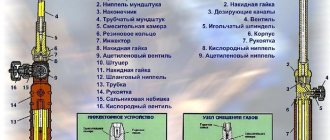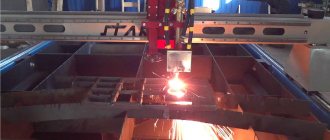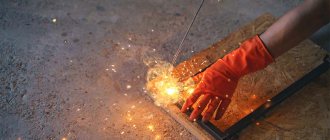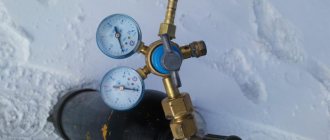Oxygen hose for gas cutting and welding GOST 9356-75
A rubber pressure hose, intended for gas cutting and gas welding work, is manufactured in accordance with the requirements of GOST 9356-75 and is often called an oxygen hose. The product is designed to supply working gas under pressure (this can be acetylene, natural gas, butane, propane, oxygen, and liquid fuel) to equipment used for gas cutting and welding. According to GOST 9356-75, the operation of oxygen hoses is possible in cold, temperate and tropical areas. The operating temperature range is determined by the climatic version - from –55 to +70 °C (cold and moderate) and from –35 to +70 °C (tropical).
The classification of oxygen gas welding hoses is based on their purpose and scope of application:
Oxygen hose marked GOST 9356-75
- class I - a series of oxygen hoses used to supply various gases or their mixtures (propane, butane, natural gas) under pressure up to 0.63 MPa;
- class II - hoses that are designed to supply liquid (A-72 gasoline, kerosene, white spirit or mixtures thereof) under pressure up to 0.63 MPa;
- class III - a series of pressure oxygen hoses used exclusively for supplying oxygen at high pressure (working pressure can be 2 and 4 MPa).
- The class of the product is indicated in the labeling.
Symbols and markings
Each oxygen hose GOST 9356-75 has a marking applied using indelible paint or in relief. Marking technology must ensure the safety and readability of markings throughout the entire service life of rubber products. For gas welding hoses having a diameter of 6.3 mm, designations can be applied to the tag rather than the hose itself.
The marking of rubber products contains the following information:
Welding sleeve with longitudinal markings
- symbols;
- brand mark or name of the manufacturer;
- batch number and release date;
- stamp of the technical control department confirming compliance with the requirements of state standards.
Colored oxygen hoses are marked using white paint. Black products are marked with color, depending on their class. Application is carried out in the form of a longitudinal line along the entire length (possibly at intervals).
The designation of the main technical and operational characteristics of oxygen hoses is encrypted in the marking. It contains:
- full name of the rubber product;
- belonging to a class;
- bore diameter (mm);
- climatic version - HL (cold climate) and T (tropical);
- GOST number, according to the requirements of which the hose is manufactured.
Thus, oxygen hoses GOST 9356-75 class II with a diameter of 16 mm, designed to supply gasoline under pressure up to 0.63 MPa and intended for use in cold areas, will be designated as follows: “Hose II 16-0.63-HL GOST 9356- 75".
Delivery of hoses for gas welding
Delivery cost in Moscow and the Moscow region: by courier - 500 rubles. (restrictions on courier delivery - no more than 50 kg and no further than 20 km from the Moscow Ring Road towards the region).
Delivery to other regions is carried out by transport companies. How to choose a transport company is described on our website in the Delivery in Russia section.
Contact number for receiving orders for delivery: +7 (495) 921-34-24 (accepted on weekdays from 9.00 to 17.00, on Saturdays from 10.00 to 14.00, and on the website - around the clock).
We do not divide orders into large and small; every customer is important to us. It's important that the next time you need something, you come back to our warehouse store.
Design features
Welding hose structure
The oxygen hose has a multi-layer design. The inner and outer layers are made of elastic rubber. The intermediate one performs a reinforcing function and can be made from either cotton fibers or synthetic fibers. The basis of the rubber layer is natural or synthetic rubber with modifiers that change its physical and chemical characteristics depending on the operating environment. The outer rubber layer of the welding sleeve can be modified to provide resistance to abrasion, ultraviolet radiation and heat.
To visually distinguish products for different purposes, the outer rubber layer can be painted in different colors:
- red - class I oxygen hoses;
- yellow - for rubber products of class II;
- blue - for class III hoses.
According to GOST 9356-75, it is allowed not to paint the outer rubber layer. In such cases, the hoses are black, but colored stripes are applied along the entire length of the product, which correspond to the class.
Gas welding hoses are flexible products. Provided that the minimum bending radius is observed, the deformation of the internal section should not exceed 10% of the nominal values.
How to choose?
When purchasing a hose, you should first determine its elasticity and wall thickness. You also need to pay attention to the rubberized layers and cord covering. It is recommended to squeeze the hose with two fingers; it should be “tight”. If the material is too soft, then after a short time a bulge will appear on the product - such a phenomenon will inevitably affect the operation of the welding machine, the pressure will be noticeably lower.
The main characteristics of hoses that should be considered when choosing:
- hose name;
- length of the product;
- what class does it belong to?
- section size;
- operating pressure;
- what temperatures is it intended for?
- what is the standard number?
Before purchasing a product, you should pay attention to some features.
If you have to work outdoors or in a large workshop, the hose length can be up to 42 meters. In enclosed small rooms this figure is usually halved. Coils are most often sold in 40, 50, 100 meters.
The weight of the product is also important if you have to work on weight. The product should not be very heavy so that your hands do not get tired. P1 cutters use 6 mm and 9 mm products. There are more powerful cutters (P3) that cut metal up to 3 cm thick. Therefore, such devices require hoses with a cross-section of 9 mm.
An important indicator is the bending radius. If the hose has a cross-section of 6 mm, then the bend radius should be 49 mm. For a hose cross section of 9 mm, a bending radius of about 78 mm is required.
Foreign products are made with various synthetic additives and elastomers, which significantly increase the performance characteristics of hoses. Innovative materials are technologically advanced and functional, but their price is slightly higher. All products are marked; when purchasing a hose, it is recommended to pay attention to the output data.
To cut metal using a semi-automatic welding machine (argon welding), you should opt for hoses of class 1 (red color). The hoses must not become twisted during operation. The welding hose is made of rubber and has vulcanized rubber gaskets.
Some manufacturers add low-quality PVC to the hose material. Such hoses cannot withstand sub-zero temperatures and quickly crack. When choosing the necessary accessory, you should opt for materials that can withstand temperatures down to -42 degrees Celsius. Hoses must not have swelling or cracks. The diameter of the tube when bent should not be less than 12%.
Quality control
Oxygen hoses are produced and subject to acceptance by technical control departments in batches. Each contains hoses of the same class and size with a total length of no more than 2000 m.
In appearance, rubber products are accepted visually; optical control devices do not need to be used. The main criteria by which the quality of hoses is determined:
- internal rubber layer - bubbles, porosity, cracks and folds are not allowed on its surface;
- outer layer - bubbles are not allowed on its surface, as well as peeling from the load-bearing frame or its bare zones.
To visually control the quality of an oxygen hose, a method is used to compare actual products with control samples.
In addition to acceptance by appearance (design, color, size), the welding hose is subjected to tests for tightness under hydrostatic pressure, tensile strength from hydraulic pressure, tests for resistance to gasoline (rubber products of class II), as well as tests for the bond strength of the rubber layer with textile reinforcement.
Additional components
Accompanying elements for gas hoses are:
- pillows;
- cylinders;
- spare hoses;
- Oxygen Concentrator.
Transportation and storage
Gas welding sleeve (hose) in packaged form
To transport oxygen welding hoses, the products are tied into coils (in three or four places) and covered with plastic film. Transportation is possible using all types of covered transport, subject to compliance with the delivery rules in force for each of them. Each package contains markings indicating the designation of the products and the total footage.
According to GOST 9356-75, storage of gas welding hoses is allowed in closed warehouses at temperatures from –20 to +25 °C. Products can be stored in coils with a maximum height of 1.5 m or in a straightened form at a distance from heat and ozone-emitting equipment. In addition, it is necessary to protect rubber products from sunlight or exposure to light from artificial sources that can emit ultraviolet radiation. Contact with substances that are aggressive to rubber or thread frames - gasoline, kerosene, alkalis, acids, etc. is not allowed.
When storing oxygen hoses at subzero temperatures, the products must be kept at room temperature for at least 1 day before installation. Warming up cannot be accelerated by increasing the temperature.
How to connect?
Hoses produced in Russia are painted black; a long red mark is applied to their surface (for butane); for oxygen there is a blue mark. Foreign manufacturers most often make hoses of different colors.
The hose is connected to the gearbox. Proper connection will allow you to work safely with any equipment. Hoses that connect to each other are especially in great demand. This allows you to use the equipment efficiently; the hoses do not get twisted or tangled on the floor.
Manufacturer's Warranty
Subject to compliance with transportation and storage requirements, the manufacturer establishes the following guarantees:
- The shelf life of the gas welding hose is two years from the date of manufacture;
- The service life of the gas welding hose (subject to the conditions of correct installation and subject to intended use) is one year within the warranty period for storage.
The manufacturing plant guarantees full compliance of gas welding hoses with the requirements of State Standard 9356-75.
Operating rules
Before using the hose, it should be carefully inspected; no cracks or breaks should be observed. Manufacturers, when producing hoses, test them in 2000 m packages. The hose must pass tests for strength and tightness, as well as for breaking loads.
The material must withstand aggressive substances such as acetylene or gasoline. Products that belong to the second type are especially carefully tested.
Products must be used in compliance with several rules.
- Hoses are used only for “their” burners.
- Before starting work, the hoses should be purged to remove talc particles.
- The products are cleaned with a gaseous mixture when the purging is completed.
- The hose length is at least 9.1 meters. The maximum size should be 30.2 meters.
- Sometimes the product is increased to 50.5 meters, but this can only be done with special permission.
- The hose can have no more than three joints. All joints are made using clamp fasteners.
- The hose is located on a flat surface; there should be no kinks. It is permissible to use twin hoses.
- Before starting work, you should conduct a test inspection. Pay special attention to connections.
- The permissible pressure for the oxygen hose is no more than 20 atmospheres. The pressure for an acetylene hose is no more than 5 atmospheres.
- Every 4 months the hoses undergo a test inspection and are tested with gas at a pressure of 10 atmospheres. Hydraulic tests are also carried out, water is driven under a pressure of 32 atmospheres.
- If a defect is found, the hoses must be repaired immediately.
- Each worker should use only “his” hose in order to know how the product works, its strengths and weaknesses.
- If everything is done correctly, then transporting gases can be done safely and easily.
Oxygen is explosive, so safety regulations must be observed, especially when it comes to transportation. All cylinders must have an integral structure and be supplied with everything necessary. It is important that the cylinder has a key.
Seam welding mechanisms are high-performance equipment that allows you to connect various sheets of metal together. This technique is not very complicated, but it makes it possible to make high-quality seams, both transverse and longitudinal.
Practical recommendations
- If there are defects on the hose, then they should not be wrapped with electrical tape or tape, but be sure to be cut off and joints made. No more than three joints are allowed.
- Hoses must not be broken or loaded with heavy objects. The hose should not be exposed to alkalis, acids or gasoline. Hoses should be kept away from electrical cables and steel cables.
- To strengthen the sleeve, you need to use stainless steel clamps. Fasteners must not have holes. The clamps should be fastened moderately - if you “tighten” them, then such fastening may not hold up and fail.
- Leak tightness is easy to check. To do this, just dilute a bar of soap in a bowl of water and use a brush to treat all the joints. There should be no bubbles; if they appear, the joints should be re-strengthened.
For an overview of the oxygen hose for gas welding work, see the following video.











